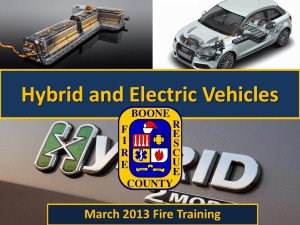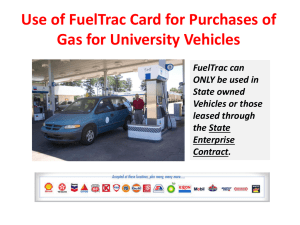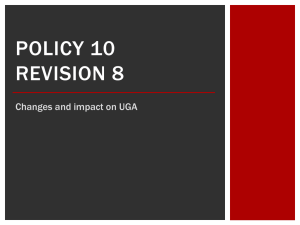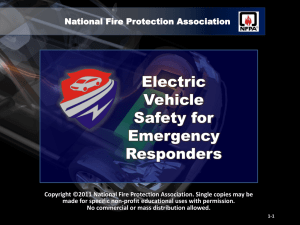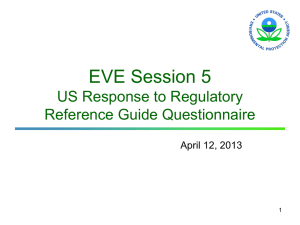CleanCitiesAtlantaLectureSlides
advertisement
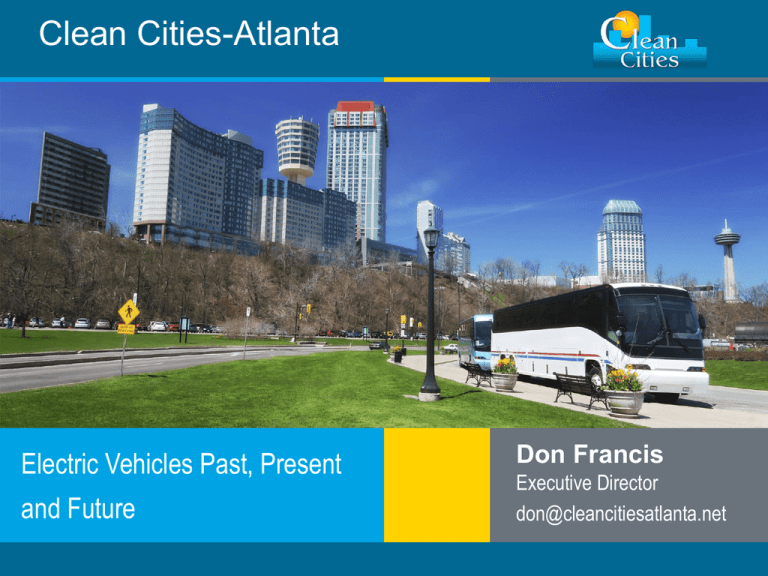
Clean Cities-Atlanta Electric Vehicles Past, Present and Future Clean Cities / 1 Don Francis Executive Director don@cleancitiesatlanta.net History of Electric Vehicles in Georgia ." Clean Cities / 2 History of Electric Vehicles in Georgia ." Clean Cities / 3 Thomas Edison Electric Car Clean Cities / 4 1915 Detroit Electric Clean Cities / 5 Georgia Power Meter Reader – 1910 Clean Cities / 6 Electric Vehicle Charging Clean Cities / 7 Facts About Electric Vehicles Today's batteries can take EVs 250+ miles on a single charge. Battery EVs are the most efficient vehicles in the world and use 3-4 times LESS energy than hydrogen fuel cell cars. Enough excess generating capacity exists at night in the U.S. to charge 180 million EVs without adding any new capacity. EVs powered by the US electrical grid are cleaner than gasoline, E85, biodiesel & fuel cells. Half of EV owners surveyed use solar energy to power their houses and cars. Plug-in cars capable of 40 miles per day would meet the needs of 80% of the American driving public. Clean Cities / 8 Sierra Club's Go Electric Campaign The future is here with electric vehicles! Automobiles, above all else, represent America's addiction to dirty oil. Plug-in electric vehicles (PEVs), which require no gasoline and emit no pollution from their tailpipes, present a critical opportunity to slash pollution, reduce dependence on oil, create American jobs, and improve national security. President Obama has set a goal of one million PEVs on U.S. roads by 2015, which would reduce carbon dioxide emissions by about 2.4 million tons a year. Clean Cities / 9 Get Ready – Here They Come Ford Focus 2011 Chevrolet Volt 2010 Tesla Roadster 2008 Transit Connect 2011 Plug-In Hybrid School Bus Nissan Leaf 2010 PHEV Utility Truck Clean Cities / 10 Smith Electric 2010 Navistar E-Star 2010 Electric Vehicles Are Coming Clean Cities / 11 Hybrid vs PEV Sales Forecast Clean Cities / 12 EV Acronyms • HEV – Hybrid Electric Vehicle • EVSE – Electric Vehicle Supply Equipment (or Charging Station) • PEV – Plug-In Electric Vehicle EV – Electric Vehicle PHEV – Plug-In Hybrid Electric Vehicle EREV – Extended Range Electric Vehicle BEV – Battery Electric Vehicle GEV – Grid Enabled Vehicle Clean Cities / 13 Hybrid Electric Vehicles Non-grid connected – engine provides power • parallel drive (Honda Integrated Motor Assist System) • serial drive (diesel electric locomotives) • combination (Toyota Synergy Drive, GM Dual Mode) Grid connected (Plug-In) – battery provides power • Chevrolet Volt , Toyota Prius PHEV • Mode 1 - charge depleting (Volt ≈ 40 mi, Toyota ≈ 15 mi) • Mode 2 - charge sustaining (“unlimited” range, 100+ mpg) Clean Cities / 14 Battery Electric Vehicles Non-road Electric Vehicle – golf cars, industrial vehicles (forklifts, airport ground support equipment) Neighborhood Electric Vehicle (NEV - LSV) – low speed vehicle (FMVSS500) • GEM • Wheego Whip Urban or City Electric Vehicle – small with limited range and speed • Wheego LiFe • TH!NK City Full Function Electric Vehicle – ICE vehicle replacement • Nissan Leaf • Ford Focus Clean Cities / 15 Infrastructure Issues V2G – Vehicle to Grid V2H – Vehicle to Home Clean Cities / 16 Impact on the Grid Electricity – An energy source with significant capacity to support transportation. 10 million PEVs would only add an additional load that is less than 1% of the total grid load. Enough excess generating capacity exists at night in the U.S. to charge 200 million PEVs without adding any new capacity. US Motor Vehicles – 250 million Clean Cities / 17 Charging Terms / Considerations Electric Vehicle Supply Equipment (EVSE) – – – – – are not chargers at all, but charging stations the charger (AC to DC) is onboard the vehicle the connector (plug) and cord set intelligence, communication, and metering capability bridges the gap between the vehicle and the grid DC Fast Charge – Not definitively defined (SAE) – Generally recharges the battery to 80% in under 30 minutes – Vehicle must be equipped to handle Clean Cities / 18 Clean Cities / 19 Contact Information Clean Cities / 20




